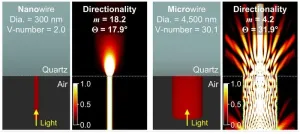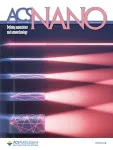(Press-News.org) Dr. Jaeyeon Pyo’s team at the Korea Electrotechnology Research Institute (KERI) has become the first in the world to reveal light emission patterns from 3D-printed nanowires, which has been published as a cover article in the prestigious scientific journal ACS Nano.
The higher resolution in display devices signifies the more of pixels in a given screen size. As pixel density increases, movies and images are displayed with greater precision and detail. In this regard, ongoing research aims to fabricate light-emitting devices smaller, from the micrometer scale (one millionth of a meter) to the nanometer scale (one billionth of a meter).
As the size of light-emitting devices shrinks to hundreds of nanometers, peculiar changes occur in the light-matter interaction, resulting in significantly different emission pattern compared to macro structures. Therefore, understanding of light emission from nanostructures is an essential prerequisite for the practical application of nanoscale light-emitting devices.
The KERI’s research team, dedicated in display research using nanophotonic 3D printing technology1) for years, revealed highly directional light emission patterns from the 3D-printed nanowires for the first time in the world.
1) A technology for implementing photonic devices using a nanoscale high-resolution 3D printing method. Fabrication of nanoscale photonic structures in 3D architecture is achieved by direct writing of functional inks formulated from various optical materials. This technology is expected to bring innovation to ultra-high-resolution displays, security printing, data storage, and more.
Typically, it is challenging to uniformly fabricate light-emitting materials of desired sizes at specific locations using conventional chemical or physical vapor deposition methods. However, KERI’s 3D printing technology allows precise control of the diameter through the restriction by the printing nozzle’s aperture, enabling the reliable fabrication of light-emitting materials at desired locations with a wide range of sizes (diameter from 1/10,000th of a meter to 1/10th millionth of a meter).
Dr. Jaeyeon Pyo’s team experimentally observed and measured light emission patterns from specimens2) precisely fabricated using the nanophotonic 3D printing technology, ranging in size from the nanometer- to micrometer-scale. The team also conducted electromagnetic wave simulations for in-depth analysis and cross-validation of their arguments.
2) Specimen : A sample prepared for experiments and analysis.
As a result, when the size of light-emitting materials becomes as small as 300 nanometers in diameter, internal reflection of light vanishes due to spatial confinement, leading to one-directional straight propagation of light. Consequently, the light emission pattern becomes highly directional. Typically, light propagates through diverse paths within a given internal structure, resulting in broad emission patterns as their superposition. However, in nanowire structures, only a single path exists, leading to the observed highly directional emission pattern.
The observed highly directional attribute can significantly enhance the performance of displays, optical storage media, encryption devices, and more. Macro-structures with broad emission patterns can suffer from optical crosstalk when densely integrated, causing signals to overlap or blur. In contrast, nanowires with highly directional emission patterns allow clear separation between signals from each structure at high densities, eliminating distortions in representation or interpretation. The highly directional emission of nanowires makes them suitable for high-performance devices, as experimentally demonstrated by KERI’s team.
This research was published as a cover article for its excellence in ‘ACS Nano’, a top-tier SCI journal in the field of nanoscience with a JCR impact factor of 15.8.
Dr. Jaeyeon Pyo stated, “Research on optical physics at the nanoscale is challenging, especially due to the difficulty in specimen preparation, which is often high-cost and time-consuming. Our contribution demonstrates that the 3D printing method can be a versatile platform for studying optical physics owing to its simple, flexible, and low-cost characteristics.” He added, “This research will significantly contribute to the cutting-edge display technologies, and quantum physics, which are part of South Korea’s ‘National Strategic Technology Nurture Plan.”
The research team anticipates that their contribution will attract significant interest in the fields of virtual reality (AR, VR), beam projectors, optical storage media, photonic integrated circuits, encryption technologies, and security printing, where ultra-small light-emitting materials can be utilized. They aim to continue investigating various optical phenomena occurring at the nanoscale using the 3D printing method, leveraging its capability for free-form fabrication.
<KERI is a government-funded national research institute under the National Research Council of Science & Technology (NST) of the Ministry of Science and ICT's. Dr. Jaeyeon Pyo is also an associate professor at the Korea National University of Science and Technology (UST).>
END
Light emission from nanostructures, revealed using 3D printing method for the first time
2024-07-23
ELSE PRESS RELEASES FROM THIS DATE:
HHMI invests over $300 million in 26 new investigators
2024-07-23
The Howard Hughes Medical Institute announced on July 23, 2024 that 26 of the nation’s leading scientists have been named HHMI Investigators.
Paving the way for new scientific and biomedical discoveries in fields ranging from neuroscience to immunology to structural biology, these scientists come from 19 US institutions and join HHMI’s current Investigator community, comprising more than 250 scientists.
HHMI will invest more than $300 million in this newest cohort over the next seven years, enabling each Investigator to push the boundaries of science.
“HHMI is committed to supporting visionary scientists who are pursuing discoveries that will change ...
Blood pressure high for years? Beware of stroke risk
2024-07-23
High blood pressure is known to increase a person’s chances of having a stroke.
But a study led by Michigan Medicine narrows in on the cumulative effects of years of high systolic blood pressure — the top number on the blood pressure reading and how hard the heart pumps blood to the arteries — finding that a higher average reading during adulthood is linked with a greater risk for the two most common types of stroke.
The study, published in JAMA Network Open, analyzed the average systolic blood pressure years ahead of the first stroke for more than 40,000 people ...
IMDEA Software creates FIXCHECK, a novel approach that improves automatic software repair by generating test cases revealing defects in 62% of incorrect patches
2024-07-23
IMDEA Software researchers Facundo Molina, Juan Manuel Copia and Alessandra Gorla present FIXCHECK, a novel approach to improve patch fix analysis that combines static analysis, randomized testing and large language models. Their innovations, embodied in the paper: "Improving Patch Correctness Analysis via Random Testing and Large Language Models" were presented at the International Conference on Software Testing, Verification and Validation (ICST 2024).
Context
Generating patches that fix software defects is a crucial task in the maintenance of software systems. Typically, software ...
New car smell reaches toxic levels on hot days
2024-07-23
A study of volatile organic compounds (VOCs) emitted by new cars on hot summer days finds concerning levels of formaldehyde and other aldehydes. Consumers are familiar with—and even drawn to—the “new car smell” produced as VOCs from carpets, upholstery, and other interior materials in newly manufactured passenger vehicles. These VOCs can cause a range of health effects, including headaches, inflammation of the eyes, nose and throat, fatigue, irritability, dry cough, lung disease, and disorientation. Jianyin Xiong, Shaodan Huang, and colleagues sought to capture the levels of VOCs in the passenger cabins of new cars on ...
A promising new method uses light to clean up forever chemicals
2024-07-23
Perfluoroalkyl substances (PFASs), nicknamed ‘forever chemicals,’ pose a growing environmental and health threat. Since the invention of Teflon in 1938, PFASs and perfluorinated polymers or PFs have been widely used for their exceptional stability and resistance to water and heat. These properties made them ideal for countless applications, from cookware and clothing to firefighting foam. However, this very stability has become a major problem. PFASs do not easily break down in the environment, leading ...
DIF-1(+3): Combating drug-resistant malaria parasites
2024-07-23
Malaria remains a serious health issue globally, especially in Africa. The disease is caused by protozoan parasites in the Plasmodium genus. In 2021, there were 247 million cases of malaria and 619,000 deaths reported worldwide. At present, the first line of treatment against malaria is artemisinin combination therapy (ACT) and the administration of artemisinin derivatives in combination with other drugs. After the introduction of ACTs in Africa, which accounts for more than 90% of the world’s malaria cases, the number of deaths due to malaria greatly declined in the mid-2000s. However, Plasmodium falciparum, the most virulent malaria parasite, is resistant to ACT and has been spreading ...
Can a World Cup run drive interest in a nation? New study finds evidence of the “flutie effect” off the field
2024-07-23
Nearly four decades ago, Boston College quarterback Doug Flutie launched a game-winning, mid-field touchdown pass to upset the University of Miami on the game’s final play—prompting a subsequent surge in applications to the school in what has been dubbed the “Flutie Effect.”
A team of NYU researchers has now found evidence of this effect beyond the gridiron—and athletic competition. During and after Morocco’s surprising run to the World Cup semi-finals in the fall 2022, online searches on non-sports topics related to Morocco increased ...
Data from largest clinical trial of pre-symptomatic Alzheimer’s disease now widely available
2024-07-23
Data from the Anti-Amyloid Treatment in Asymptomatic Alzheimer’s (A4) study, the first and largest clinical trial of pre-symptomatic Alzheimer’s disease, is now widely available to researchers studying the condition. The comprehensive dataset has already yielded key insights about Alzheimer’s disease, which affects nearly seven million people in the United States, and sharing the data opens avenues for further progress.
A4 researchers screened more than 7,500 people and enrolled 1,169 people with pre-symptomatic Alzheimer’s disease. This stage ...
Fruit fly post-mating behavior controlled by male-derived peptide via command neurons – study
2024-07-23
Scientists have succeeded in pinpointing the neurons within a female fruit fly’s brain that respond to signals from the male during mating.
Male fruit flies transfer a substance called a sex-peptide during mating in the seminal fluid together with sperm. This sex pheromone influences the female fly’s behaviour so she will start to lay eggs and be less inclined to mate further.
This is a common phenomenon in insects but until now, it was not known where in the nervous system the neurons are located that direct ...
NIH findings shed light on risks and benefits of integrating AI into medical decision-making
2024-07-23
Researchers at the National Institutes of Health (NIH) found that an artificial intelligence (AI) model solved medical quiz questions—designed to test health professionals’ ability to diagnose patients based on clinical images and a brief text summary—with high accuracy. However, physician-graders found the AI model made mistakes when describing images and explaining how its decision-making led to the correct answer. The findings, which shed light on AI’s potential in the clinical setting, were published in npj ...





